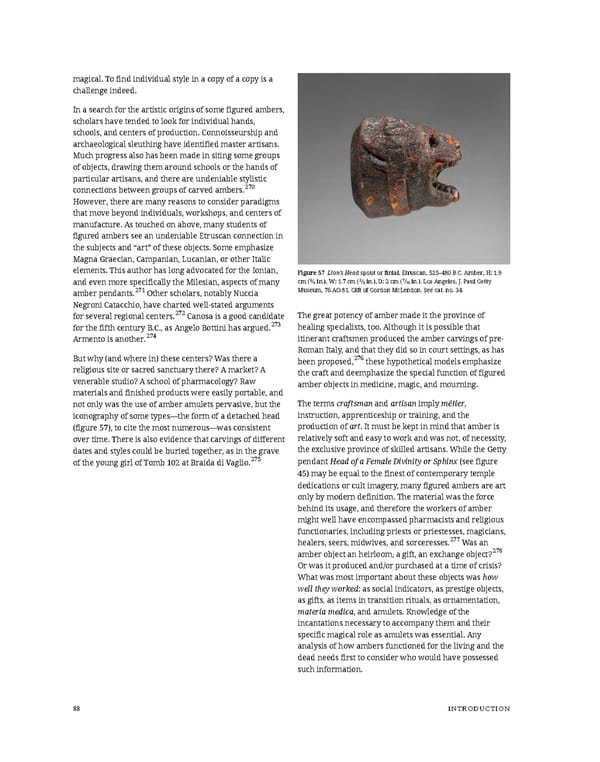magical. To find individual style in a copy of a copy is a challenge indeed. In a search for the artistic origins of some figured ambers, scholars have tended to look for individual hands, schools, and centers of production. Connoisseurship and archaeological sleuthing have identified master artisans. Much progress also has been made in siting some groups of objects, drawing them around schools or the hands of particular artisans, and there are undeniable stylistic connections between groups of carved ambers.270 However, there are many reasons to consider paradigms that move beyond individuals, workshops, and centers of manufacture. As touched on above, many students of figured ambers see an undeniable Etruscan connection in the subjects and “art” of these objects. Some emphasize Magna Graecian, Campanian, Lucanian, or other Italic elements. This author has long advocated for the Ionian, Figure 57 Lion’s Head spout or finial, Etruscan, 525–480 B.C. Amber, H: 1.9 and even more specifically the Milesian, aspects of many cm (3⁄4 in.), W: 1.7 cm (2⁄3 in.), D: 2 cm (7⁄10 in.). Los Angeles, J. Paul Getty amber pendants.271Other scholars, notably Nuccia Museum, 76.AO.81. Gift of Gordon McLendon. See cat. no. 34. Negroni Catacchio, have charted well-stated arguments for several regional centers.272 Canosa is a good candidate The great potency of amber made it the province of for the fifth century B.C., as Angelo Bottini has argued.273 healing specialists, too. Although it is possible that Armento is another.274 itinerant craftsmen produced the amber carvings of pre- Roman Italy, and that they did so in court settings, as has But why (and where in) these centers? Was there a been proposed,276 these hypothetical models emphasize religious site or sacred sanctuary there? A market? A the craft and deemphasize the special function of figured venerable studio? A school of pharmacology? Raw amber objects in medicine, magic, and mourning. materials and finished products were easily portable, and not only was the use of amber amulets pervasive, but the The termscraftsmanandartisanimplymétier, iconography of some types—the form of a detached head instruction, apprenticeship or training, and the (figure 57), to cite the most numerous—was consistent production of art. It must be kept in mind that amber is over time. There is also evidence that carvings of different relatively soft and easy to work and was not, of necessity, dates and styles could be buried together, as in the grave the exclusive province of skilled artisans. While the Getty of the young girl of Tomb 102 at Braida di Vaglio.275 pendantHead of a Female Divinity or Sphinx (see figure 45) may be equal to the finest of contemporary temple dedications or cult imagery, many figured ambers are art only by modern definition. The material was the force behind its usage, and therefore the workers of amber might well have encompassed pharmacists and religious functionaries, including priests or priestesses, magicians, healers, seers, midwives, and sorceresses.277 Was an amber object an heirloom, a gift, an exchange object?278 Or was it produced and/or purchased at a time of crisis? What was most important about these objects was how well they worked: as social indicators, as prestige objects, as gifts, as items in transition rituals, as ornamentation, materia medica, and amulets. Knowledge of the incantations necessary to accompany them and their specific magical role as amulets was essential. Any analysis of how ambers functioned for the living and the dead needs first to consider who would have possessed such information. 88 INTRODUCTION
 Ancient Carved Ambers in the J. Paul Getty Museum Page 97 Page 99
Ancient Carved Ambers in the J. Paul Getty Museum Page 97 Page 99